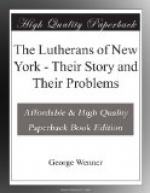Fifty years ago I was browsing one afternoon over the books in the library of Union Theological Seminary, at that time located in University Place. I was all alone until Dr. Samuel Hanson Cox, the father of Bishop Arthur Cleveland Coxe, came in. He was then in his eighties, but vigorous in mind and body. We easily became acquainted and I was an eager listener to the story of his early ministry in New York, which fell about the time of which we are speaking. From him I got a picture of life in New York closely corresponding with that which is given in Dr. Francis’ interesting story. There were leaders of the church in those days who were not free from the vice of drunkenness. Evangelical religion in all denominations had a severe conflict in doctrine and in morals with the ultra liberal tendencies of the time.
A marked defect of our church life was the inadequate supply of men for the ministry. For 140 years New York Lutherans had been dependent upon Europe for their pastors. For 60 years more this dependence was destined to continue.
Kunze had long been desirous of providing facilities for theological education in this country. Under the bequest of John Christopher Hartwig, he organized in 1797 a Theological Seminary. The theological department was conducted in New York by himself, the collegiate department in Albany and the preparatory department in Otsego County.
One of his students was Strebeck. Another, Van Buskirk, a promising young man, died before he could enter the work. The Mayer brothers, natives of New York, became eminent pastors of English Lutheran churches, Philip in Albany and Frederick in Philadelphia. It was a trying time in which Kunze lived, but he planted seed which still bears fruit.
One event of the eighteenth century seems worthy of spcial [sic] mention, even when seen through the vista of a hundred and fifty years, although at the time it may have attracted little attention. Because of the side light which it throws upon history we permit it to interrupt for a moment the course of our story.
It harks back to the refugees from the Palatinate who emigrated to the west coast of Ireland at the same time that their fellow countrymen under Kocherthal came to New York. Their principal settlements were at Court-Matrix, Ballingran and other places in County Limerick near the banks of the river Shannon. As they had no minister and understood little or no English, in the course of forty years they lost whatever religion they had brought with them from Germany. It came to pass that John Wesley visited these villages. He found the people “eminent for drunkenness, cursing, swearing, and an utter neglect of religion.” (Wesley’s Journal, II, p. 429.)
Wesley’s sermons reminded them of the sermons they used to hear in their far-off German home, and a remarkable revival occurred among them. Subsequently numbers of them followed their countrymen of the preceding generation to New York and some of them joined the Lutheran Church. Among the names to be found on the records of our church are those of Barbara Heck and Philip Embury.




